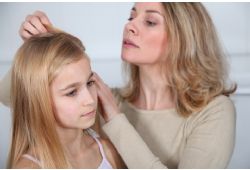Head lice are very common,
especially among children. These pesky creatures are particularly contagious
and frustrating to deal with. Worse yet, they can be difficult to get rid of.
What Exactly are Lice?
Head lice are tiny, wingless
parasites that live in people’s hair. They sustain themselves by sucking small
amounts of blood from the scalp. They’re different from body lice or animal
parasites, and are not caused by poor hygiene. Nor are they dangerous or do
they spread disease.
They most
often affect children aged three to 11 years old. The infestations reach an
all-time peak at eight or nine years old. The lice life cycle operates in three
stages; the egg (nit), the nymph and the adult. Lice can live up to thirty days
on a person’s head and die quickly after leaving the scalp.
Notoriously Contagious
Head lice spread easily from
direct hair-to-hair contact. They are unable to fly or jump, but they can crawl
and lay eggs quickly.
Brenda
McConnell is a mother of two. Both her children contracted head lice and as a
result, she got it too. After treating their hair, she had to continue combing
and inspecting everyone for weeks. “That was the hardest part; constantly
checking, combing, and then washing the bedding and any pillows or blankets my
children lay on,” McConnell says.
Symptoms & Treatment
The most common symptom is an itchy,
irritable scalp. Keep in mind that most itchy scalps are not cause by head lice.
Conversely, it’s possible to have head lice without any symptoms. But if your
child complains of an itchy scalp or if there’s an infestation at their school,
parents are advised to do an immediate inspection.
Have your
child sit comfortably while you carefully inspect their hair in a well-lit
area. The use of a magnifying glass can also be helpful. Lice and nits are mostly
located close to the scalp, at the bottom of the neck and behind the ears. Even
if you don’t see any lice, it’s crucial to look for nits. Nits are often confused
with dandruff. The difference is that while dandruff may be easily removed,
nits are firmly attached to the hair shaft.
If your child
has nits, remove them using a lice comb. If your child has lice, go to a pharmacy
to get the proper treatment. Evangelia Spiratos is a registered nurse who works
at several Montreal schools. “Some products have been around for a long time
and lice have become resistant to them,” she says. “There are some newer
products that are more effective and do not include pesticides.” She adds that
it is essential to follow the exact directions and do the recommended number of
applications to ensure you stop the cycle.
Spiratos also
warns that every single nit must be removed. If you’re not thorough and you
leave one behind, it will eventually hatch and you may be caught in a vicious
cycle.
Prevention Tips
Stefani Qureshi is a Montreal
mother whose daughter contracted head lice. She recalls that although the treatment
was very laborious, it was necessary. She adds that some parents may feel
ashamed and don't want to tell anyone when their child has it. “Keeping it a
secret is worse because then no one can take preventative action,” Qureshi
says. “As parents, we have a responsibility to be vigilant and advise when
something in not going right.”
Luckily, there are preventative measures
parents can take. Here are five quick tips;
- Avoid head to head contact.
- Keep long hair tied or braided.
- Don’t let your children share hairbrushes, combs or hats.
- Inspect your child and watch for frequent head scratching.
- Although there is no scientific proof of their effectiveness, some parents use head lice prevention sprays or essential oils such as tea tree or lavender.

 In The Latest Issue:
In The Latest Issue:


 BY:
BY: 

Tweet
Share